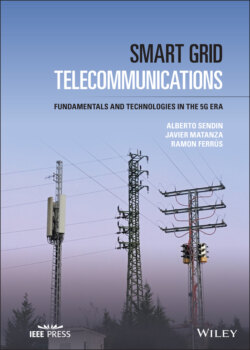Читать книгу Smart Grid Telecommunications - Ramon Ferrús - Страница 41
1.6.2 Standards for Telecommunications for Smart Grids
ОглавлениеThe initiatives to standardize ICT‐related Smart Grid solutions started to crystallize in the 2010s. The overarching idea was to define some reference architectures, identify existing standard solutions, identify gaps in them for Smart Grid purposes, and both adopt and adapt existing standards to eventually create new ones where appropriate.
Different efforts have taken place. The reference models and compilations of solutions are useful but lack specific examples on how to use them to provide real solutions. Their value comes from the identification of applicable standards and the process to produce new ones.
Standards ([45]) are instrumental to achieve interoperability, and within their different scopes, they must allow for the interconnection of standard‐compliant equipment from different manufacturers. Standards have many origins; solutions that end‐up being a standard not always start in standardization bodies. The most extreme case is de‐facto standards that, starting purely in industry, may end as a formal standard solution.
IEC, ITU, IEEE, ETSI, CEN, CENELEC and ANSI are probably the main standardization bodies that have engaged with Smart Grids.
IEC's (International Electrotechnical Commission) influence domain is within electrotechnologies (i.e., electrical, electronics, and related technologies) and is probably one of the best options for Smart Grid standards to grow. IEC members are the National Committees (one country, one vote) that appoint delegates and experts to produce consensus‐based standards. The IEC identified hundreds of Smart Grids standards [46].
ITU (International Telecommunication Union) is the United Nations’ agency specializing in ICT and is organized in three sectors, namely, Radiocommunications (ITU‐R), Standardization (ITU‐T), and Development (ITU‐D). A major role of ITU is on radiocommunications (the World Radiocommunication Conference – WRC – being the major reference point), coordinating spectrum allocation at a worldwide level. ITU‐T created a focus group for Smart Grid activities, now within Study Group 15 [47]. Many relevant Smart Grid‐applicable ITU recommendations will be mentioned throughout the different chapters.
IEEE (Institute of Electrical and Electronics Engineers) is a well‐known technical professional organization serving professionals involved in all aspects of the electrical, electronic, and computing fields and related areas of science and technology. IEEE is organized in “societies,” and the ones related to Smart Grid activities are the IEEE Communications Society and the IEEE Power & Energy Society. The IEEE references over 100 standards related to the Smart Grid, and many of them will be mentioned along this book.
ETSI (European Telecommunications Standards Institute) [48] is the European Union (EU) ICT‐related recognized body, that jointly with CEN (Comité Européen de Normalisation, or European Committee for Standardization) [49] and CENELEC (Comité Européen de Normalisation Electrotechnique, or European Committee for Electrotechnical Standardization) [50] are the European Standard Organizations. The ETSI works closely with the National Standards Organizations (NSOs) in the European countries, to an extent that all European Standards (ENs) become national standards of the different European member states. ETSI works very close to the EU institutions, and in the Smart Grid domain, the European Commission issued M/490, M/441 and M/468 mandates to CEN, CENELEC, and ETSI to develop standards for Smart Grids, Smart Metering, and EV charging.
ANSI (American National Standards Institute) [51] works also very closely with USA institutions, to facilitate the standardization and conformity assessment in the United States, for the better performance of the internal market. ANSI develops accreditation services to assess the competence of organizations certifying products and personnel and provides a framework for American National Standards (ANSs) to be developed out of common agreements. The ANSI label may be used when the organization producing the standard meets ANSI requirements; this is the case with the IEEE.
Last but not least, 3GPP (3rd Generation Partnership Project) [52] unites a set of telecommunications standard development organizations (ARIB, ATIS, CCSA, ETSI, TSDSI, TTA, TTC) in a stable environment to produce the so‐called 3GPP technologies' specifications. These specifications cover cellular telecommunications technologies for mobile telecommunications.
